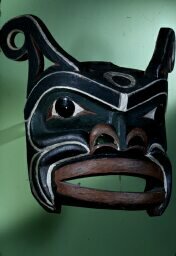Major Donors
Dr. June Helm
September 13, 1924 - February 5, 2004
September 13, 1924 - February 5, 2004
To know about a past for which there are no written records, physical remains must be studied in an orderly way. As with any science, this field is continually changing as new discoveries are made and new ideas are developed. The following is a brief discussion on Wisconsin archaeology, generally representing the views of archaeologists and anthropologists.
The Northeast region includes portions of southeastern Canada, and is bordered in the United States by the Mississippi River and Atlantic Coast. The tribes of this region represented in the Museum’s cradleboard collection are the Iroquois (4) and (1) Oneida example specifically, Menominee (1), Mexican Kickapoo (2), Ojibwa/Chippewa (7), Potawatomi (3), Sauk (1), and Winnebago/Ho-Chunk (3).
The first treaty the Menominee signed with the United States was in 1817. Like most Midwestern tribes, the Menominee sided with the British during the War of 1812, and after the conflict ended, the United States made peace with all the tribes which had opposed it during the war. The 1817 Treaty restored a state of peace between the United States and the Menominee, and the tribe sold no lands at this time.
 For the indigenous First Nations of Canada’s Pacific coast, masks are more than mere decoration or ceremonial props; they are part of a living tradition that connects people to their community, their collective past, their creator, their ancestors, their cosmology, and powerful elemental forces.
For the indigenous First Nations of Canada’s Pacific coast, masks are more than mere decoration or ceremonial props; they are part of a living tradition that connects people to their community, their collective past, their creator, their ancestors, their cosmology, and powerful elemental forces.The majority of the masks presented here were made by Kwakiutl[1] (now known as Kwakwak
During the 1980s and early 1990s, there were many violent clashes in northern Wisconsin over the issue of Ojibwe spearfishing. Violent scenes at boat landings received national and even international attention. Sometimes, thousands of White protesters showed up at boat landings as Ojibwe fishermen prepared to spearfish walleye and other species of fish. These crowds often shouted racial slurs, threw things at the fishermen, and even assaulted them.
The Menominee, who speak a language of the Algonkian language family, are the only present-day tribe in Wisconsin whose origin story indicates they have always lived in the state. The Menominee refer to themselves as Mamaceqtaw (pronounced ma-ma-chay-tau), meaning "the people." Other Indians called them Menominee (also spelled Menomini), derived from manomin, an Algonkian word for wild rice, because it is a major food source for the tribe.
Songs accompanied ceremonies for the dead, preparations for war, nearly all the games, and were essential in treating the sick. For the observance of the Midewiwin rites, the songs were as important as the spiritual leaders themselves because there could be no rituals without the appropriate songs. Many songs were inspired by dreams either during an individual's vision quest or later in his life.
The beings that make up Kwakiutl mythology are remarkably diverse. Accounts of their interactions with humans and each other are passed along through stories that not only form the basis of traditional Kwakiutl spiritual and ceremonial life and lore, but also connect Kwakiutl families to their ancestral pasts. Many contemporary Kwakiutl identify themselves as Christians but incorporate traditional mythology into their faith, freely blending elements of Christian and indigenous religion.